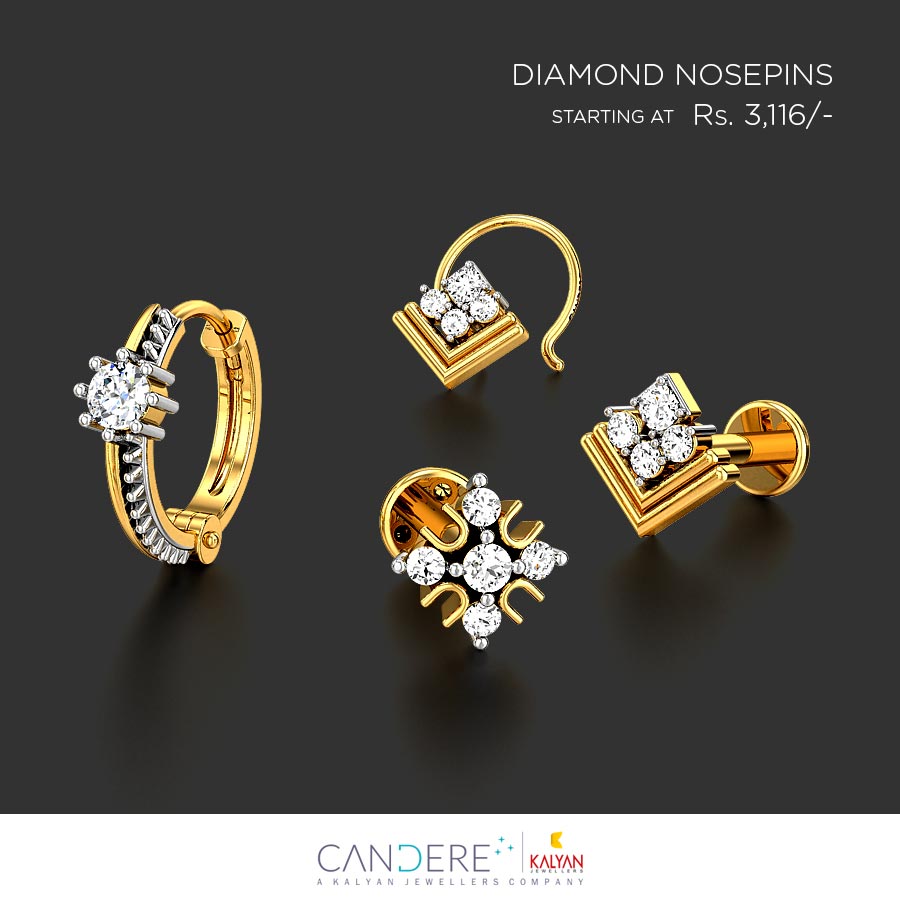It has become a popular accessory across various cultures, offering a blend of aesthetic appeal, tradition, and personal expression. Here’s a detailed exploration of nose pins:
1. Types of Nose Pins
Nose pins come in a variety of styles, each suited to different preferences and purposes:
- Nose Stud: This is the most common type of nose pin. It consists of a small pin with a decorative element such as a gemstone, metal ball, or simple design at the front. The pin is inserted through the nostril and secured by a backing or friction to hold it in place.
- Nose Ring: A circular hoop worn through the nostril or septum. It is a popular choice for those who prefer a bolder look. Nose rings can be simple hoops or come with decorative elements such as charms or beads.
- Nose Screw: Similar to the nose stud, the nose screw has a curved post that prevents it from falling out. It’s ideal for people with active lifestyles, as the curve helps keep the pin securely in place.
- L-Shape Nose Pin: This type of nose pin has a post shaped like the letter “L.” One side is inserted into the nostril, and the bend at the end helps keep it secure without requiring a backing.
- Septum Ring: While technically a type of nose pin, the septum ring is worn through the septum, the tissue dividing the nostrils. It can range from simple hoops to more elaborate designs.
2. Materials Used in Nose Pins
Nose pins are made from various materials, each offering different benefits, durability, and aesthetics:
- Gold: Gold nose pins are highly prized for their beauty and hypoallergenic properties. Available in 14K, 18K, or 22K, they can range from subtle, small pins to larger, more intricate designs. Gold is a popular choice in many cultures, especially for brides in India.
- Silver: Silver is another widely-used material, offering affordability and elegance. It is ideal for everyday wear but may tarnish over time. Sterling silver is commonly used due to its durability.
- Titanium: This lightweight, hypoallergenic material is often used for people with sensitive skin or those prone to allergic reactions. Titanium is strong and resistant to corrosion, making it ideal for body piercings.
- Surgical Steel: Known for its strength and biocompatibility, surgical steel is commonly used for initial piercings. It’s less likely to cause allergic reactions compared to nickel and is durable for long-term use.
- Platinum: Platinum nose pins are high-end pieces that offer durability, elegance, and resistance to tarnish. It is hypoallergenic, making it an excellent choice for people with sensitive skin.
- Plastic or Acrylic: Plastic and acrylic are often used for temporary or casual piercings. They are affordable and come in various colors, but they are not as durable as metals and may not be suitable for long-term use.
3. Cultural and Traditional Significance
- India: In India, nose pins (or nath when worn as a ring) are integral to cultural practices, especially for women. In some Indian cultures, the size and design of the nose pin indicate social status or wealth.
- Middle East & Africa: In many Middle Eastern and African cultures, nose piercings have long been a symbol of beauty, status, or even protection. For example, in some cultures, a nose ring can signify maturity, wealth, or a woman’s role within her community.
4. Getting a Nose Piercing
The process of getting a nose pin involves piercing the nostril or septum using a sterilized needle. Here’s an overview:
- Procedure: A professional piercer marks the area, sterilizes the skin, and uses a needle to create a hole in the nostril or septum. The nose pin is then inserted into the hole. The process is quick, but it may cause temporary discomfort.
- Healing: After the piercing, it takes 2 to 3 months for a nostril piercing to heal and 3 to 6 months for a septum piercing. During this time, it’s essential to clean the piercing with saline solution and avoid touching it with unclean hands to prevent infection.
- Pain: The pain from a nose piercing is typically brief and ranges from a mild sting to a pinch. The pain is usually less intense than other body piercings, but it can vary from person to person.
5. Fashion and Styling
Nose pins are not just for cultural or symbolic purposes—they also serve as an accessory to express personal style:
- Simple and Elegant: Some people opt for subtle designs like a tiny diamond or a metal ball for a minimalist look.
- Bold and Decorative: Larger designs with gemstones, patterns, or intricate metalwork can make a statement. Some nose pins have colored stones, such as sapphires or emeralds, to match other jewelry.
6. Care and Maintenance
To ensure the piercing heals properly and to prevent complications, regular care is essential:
- Cleaning: Clean the nose pin regularly with saline solution or an antiseptic recommended by the piercer to reduce the risk of infection.
- Avoiding Irritants: Keep hair sprays, perfumes, and makeup away from the piercing during the healing process. These chemicals can irritate the wound and slow healing.
7. Possible Risks and Side Effects
- Common signs of infection include redness, swelling, discharge, or increased pain.
- Allergic Reactions: Some people may experience allergic reactions to certain metals, particularly nickel. Switching to a hypoallergenic material like titanium or surgical steel can help.
- Keloid Scarring: Some individuals are prone to keloid scarring, which causes raised scars around the piercing site.
8. Trends in Nose Pins
- Custom Designs: Many people now opt for custom-designed nose pins, including unique gemstones, engravings, or mixed metals.
- Temporary Options: Fake nose pins are available for those who want to avoid the commitment of a permanent piercing. These can be magnetic or adhesive and are great for people who want to experiment with the look.
Conclusion
A nose pin is more than just a piece of jewelry; it is a symbol of culture, tradition, and personal style. Whether simple or ornate, gold or titanium, nose pins offer a wide range of choices to suit individual preferences.





